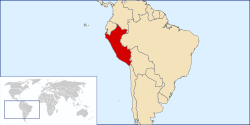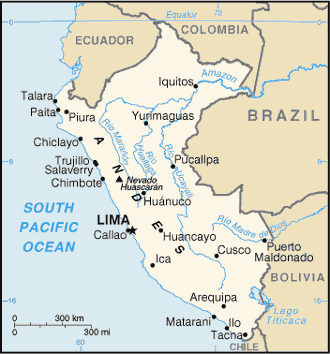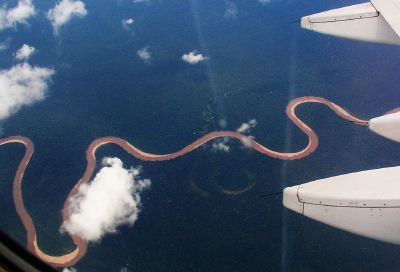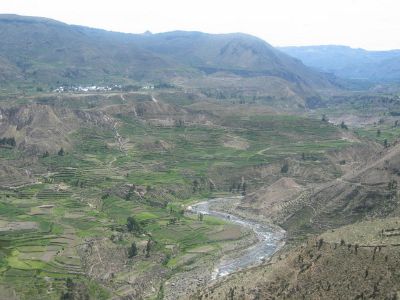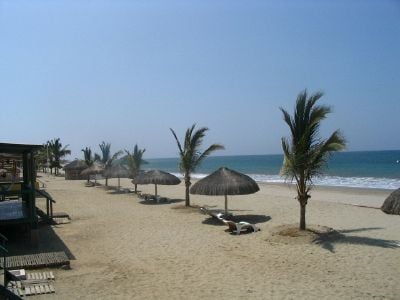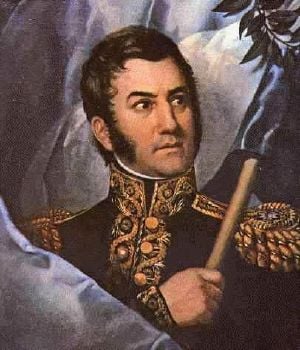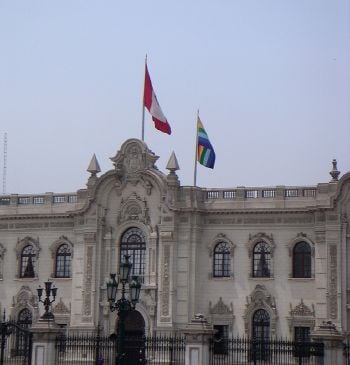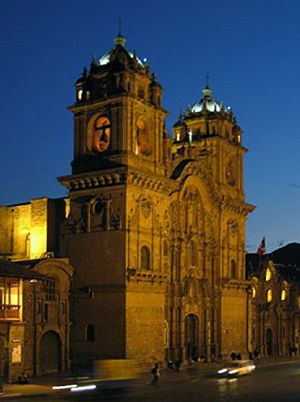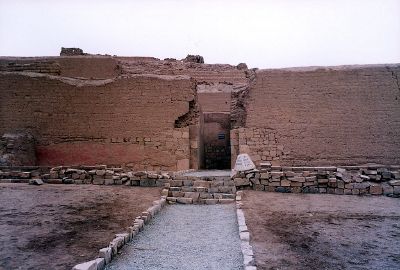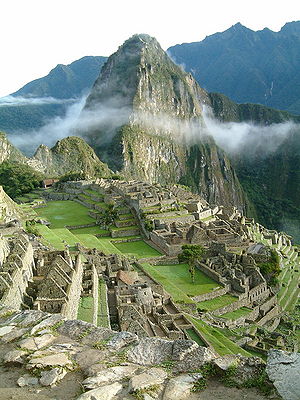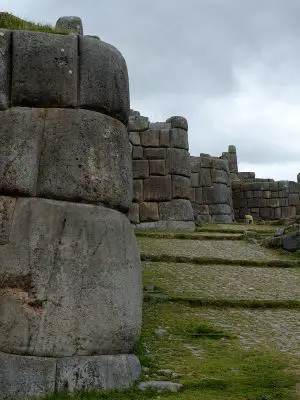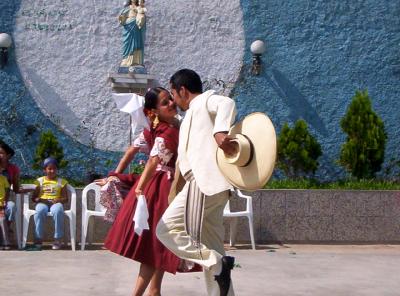Peru
| Rep√ļblica del Per√ļ Republic of Peru |
||||||
|---|---|---|---|---|---|---|
|
||||||
| Anthem:¬†"Himno Nacional del Per√ļ"¬†(Spanish) "National Anthem of Peru" |
||||||
| Capital (and largest city) | Lima 12¬į2.6‚Ä≤S 77¬į1.7‚Ä≤W | |||||
| Official languages | Spanish | |||||
| Demonym | Peruvian | |||||
| Government | Unitary presidential republic | |||||
|  -  | President | Dina Boluarte | ||||
|  -  | Prime Minister | Alberto Otárola | ||||
| Independence | from Spain  | |||||
|  -  | Declared | July 28, 1821  | ||||
|  -  | Consolidated | December 9, 1824  | ||||
|  -  | Recognized | August 14, 1879  | ||||
| Area | ||||||
|  -  | Total | 1,285,216 km² (20th) 496,225 sq mi  |
||||
|  -  | Water (%) | 0.41 | ||||
| Population | ||||||
|  -  | 2023 estimate | 32,440,172[1] (46th) | ||||
|  -  | Density | 23/km² (197th) 57/sq mi |
||||
| GDP (PPP) | 2023 estimate | |||||
|  -  | Total | |||||
|  -  | Per capita | |||||
| GDP (nominal) | 2023 estimate | |||||
|  -  | Total | |||||
|  -  | Per capita | |||||
| Gini (2021) | 40.2[3]  | |||||
| Currency | Nuevo Sol (PEN) |
|||||
| Time zone | PET (UTC-5) | |||||
| Internet TLD | .pe | |||||
| Calling code | [[++51]] | |||||
| 1 | Quechua, Aymara and other indigenous languages are co-official in the areas where they are predominant. | |||||
Peru, officially the Republic of Peru, is a country in western South America, bordering the Pacific Ocean. The third-largest country in South America, it is approximately three times the size of California. In addition to being known as the cradle of the Inca empire, Peru harbors many indigenous ethnic groups, making it a major historical and cultural site. It is also a land of extremes; from desert in the southwest to rainforest in the northeast and from the mountaintops of the Andes to the depths of Colca Canyon (twice as deep as the Grand Canyon in the United States).
When the Spanish landed in 1531, the Inca empire extended over a vast region from northern Ecuador to central Chile. In search of Inca wealth, the Spanish explorer Francisco Pizarro, who arrived in the territory after the Incas had fought a debilitating civil war, conquered the weakened people. The Spanish had captured the Incan capital at Cuzco by 1533, and consolidated their control by 1542. Gold and silver from the Andes enriched the conquerors, and Peru became the principal source of Spanish wealth and power in South America.
The vice-royalty established at Lima in 1542 initially had jurisdiction over all of the Spanish colonies in South America. By the time of the wars of independence (1820-1824), Lima had become one of the most distinguished and aristocratic colonial capitals and the chief Spanish stronghold in the Americas. After achieving independence in 1821, Peru has undergone periods of political unrest and fiscal crisis as well as periods of stability and economic upswing.
Geography
Peru's territory has an area of 496,225 square miles (1,285,216 square kilometers). It is bordered by Ecuador and Colombia on the north, Brazil and Bolivia to the east, and Chile and Bolivia to the south. To the west lies the Pacific Ocean. Peru's capital, Lima, is located on the coast, about eight miles (13 km) from the Pacific. Lima is home to almost a third of Peru's total population, with a total of two-thirds of the country's population living in the coastal region.
In the southeast along the border with Bolivia lies Lake Titicaca ‚ÄĒ at 12,500 feet (3,810 m) the highest navigable lake in the world. It is 350 miles (560 km) long and 100 miles (160 km) wide and contains 30 islands. The Altiplano plateau is a dry basin located along the slopes of the Andes in southeastern Peru. Along the border with Chile, the Atacama Desert is the driest place on the planet.
Peru is divided into three major regions. The western coast contains dry, desert-like regions to the north as well as to the south, with more agriculturally productive lands along the major valleys formed by the western-draining Andean rivers. The central Andes run as the backbone of Peru and are comprised of two large mountain ranges with spectacular snow-capped volcanoes and temperate mountain valleys. The average height in the region is around 12,000 feet (3,660 m). In the northeast, the large region of Amazonian tropical forest has recently been the scene of oil exploration. Peru's tropical forest basin also is the source of three of the major tributaries of the Amazon River: the Ucayali, Huallaga, and Mara√Ī√≥n Rivers.
The climate is arid and mild in the coastal area, temperate to frigid in the Andes, and warm and humid in the jungle lowlands.
Among the animals unique to the Andes are the condor and the llama. The puma, or mountain lion, was revered by the Incas as a symbol of strength. The llamas were used by the Incas to carry burdens; and both llamas' and alpacas' wool and hide were used for clothing. The vizcacha is a member of the chinchilla family.
The rainforest is home to animals including tapirs, jaguars, snakes, monkeys, alligators, and piranhas. Its plant life is also extremely diverse.
History
Ancient cultures
Archaeological evidence indicates that hunter-gatherers have inhabited Peru for about twenty thousand years, based on evidence present in the caves of Piquimachay (Ayacucho), Chivateros, Lauricocha, Paijan, and Toquepala. Some of the oldest identifiable cultures appeared ca. 6000 B.C.E. in the coastal provinces of Chilca and Paracas and in the highlands province of Callejon de Huaylas.
Over the following three thousand years humans became agrarian, judging from sites such as Kotosh and Huaca Prieta. Cultivation of plants such as corn and cotton began, as well as the domestication of animals including alpaca and llama. Inhabitants practiced domestic crafts such as spinning and knitting of cotton and wool, basketry and pottery. Some of the more advanced Andean civilizations that appeared long before the arrival of the Incas were:
- Caral-Supe Civilization (ca. 2500 B.C.E. - )
- Chavin (1000 to 500 B.C.E.)
- Paracas (750 B.C.E. and 100 C.E.
- Mochica (Moche) (flourished 100 - 750 C.E.)
- Tiahuanaco or Tiwanaku (possibly pre-existing the Egyptian Pyramids)
- Nazca (Classic Nazca (approximately 250-750 C.E.)
Other cultures include:
- Wari or Huari (ruling 700 to 1000 C.E.)
- Chimu (ruling 1100 to late 1400s)
These cultures developed relatively advanced techniques of cultivation, metallurgy, gold and silver work, pottery, and knitting and weaving. Some had underground irrigation systems, and grand monuments constructed of 100-ton stones. Around 700 C.E. they also developed systems of social organization that were the precursors of the Inca civilization.
Not all Andean cultures were willing to offer their loyalty to the Incas as they expanded their empire, and many were openly hostile.
The Incas
The Incas created the most vast and powerful empire of pre-Columbian America. It dominated a territory that included from north to south Ecuador, part of Colombia, the northern half of Chile and the northeast part of Argentina; and from west to east, from Bolivia to the Amazon rainforest.
The empire originated from a tribe based in Cuzco, which became the capital. Pachacuti was the first ruler to considerably expand the boundaries of the Cuzco state. His offspring later ruled an empire by variously violent and peaceful conquest. The empire's administrative, political, and military center was located in Cuzco.
Colonial rule
Francisco Pizarro and his brothers were attracted by the news of a rich and fabulous kingdom. In 1531, they arrived in the country, which they called Peru. At that moment, the Inca empire was sunk in a five-year civil war between two princes, Atahualpa and his brother Huascar. Taking advantage of this, Pizarro carried out a coup d‚Äô√©tat, taking the emperor captive, at which point the Incan army fled. Spanish domination was consolidated as successive indigenous rebellions were brutally repressed. Lima was established in 1535 and became the political and administrative headquarters. With the arrival of the Viceroy Francisco de Toledo in 1572, the Spanish promoted economic development and mineral extraction. He took advantage of the Inca institution of required public service called ‚Äúmita‚ÄĚ (a Quechua term mit'a meaning "season," or "term of labor") to subject the native communities to cruel economic enslavement.
The Viceroyalty of Peru became the richest and most powerful Spanish Viceroyalty of America in the eighteenth century. The creation of the Viceroyalties of New Granada and Rio de la Plata (at the expense of its territory), the commerce exemptions that moved the commercial center from Lima to Caracas and Buenos Aires, and the decline of mining and textile production determined the progressive decay of the Viceroyalty of Peru. These events created a favorable climate so that emancipating ideas had an effect on the Creoles.
Wars of independence
The economic crisis favored the indigenous rebellion that erupted from 1780 to 1781. This rebellion was headed by Tupac Amaru II. At the time, Napoleon Bonaparte's invasion of the Iberian Peninsula and the degradation of royal power took place. The Creole rebellion of Hu√°nuco arose in 1812 and the rebellion of Cuzco arose between 1814 and 1816. These rebellions defended the liberal principles sanctioned by the Constitution of Cadiz of 1812.
Supported by the power of the Creole oligarchy, the Viceroyalty of Peru became the last redoubt of Spanish dominion in South America. This Viceroyalty succumbed after the decisive continental campaigns of Simón Bolivar and Jose de San Martin. San Martin, who had displaced the realists of Chile after the battle of the Andes, proclaimed the independence of Peru in Lima on July 28, 1821. Three years later, Spanish dominion was eliminated definitively after the battles of Junín and Ayacucho. The first elected president, however, was not in power until 1827.
Early republican period
The conflict of interests that faced different sectors of the Creole society and the particular ambitions of the caudillos made the organization of the country excessively difficult. Only three civilians could accede to the presidency in the first 75 years of independence.
After the splitting of Alto Peru in 1815, Bolivia was created. In 1828 Peru fought a war against Gran Colombia over control of Jaén and Maynas territory, called the Gran Colombia-Peru War. After the war, Peru retained control over the territory. This was its first international conflict as a new nation. In 1837, the Peru-Bolivian Confederation was also created, but it was dissolved two years later due to Chilean military intervention.
Between these years, political unrest continued, and the army was an important political force. Peru initiated a period of political and economic stability in the middle of the nineteenth century, under General Ramon Castilla's caudillista hegemony. The complete depletion of guano, the main foreign currency source, and the War of the Pacific with Chile because of the dispute over the saltpeter deposits of Tarapac√°, caused economic bankruptcy and stirred up social and political agitation.
In 1864, Spain organized a so-called naval expedition, whose main objective was to recover control of its former colonies. Spain started occupying the Chinchas Islands and arresting Peruvian citizens in 1864, claiming that Spaniards were mistreated on Peruvian soil. After that, the Spanish fleet destroyed the Chilean harbor of Valparaiso. Chile, Ecuador, Bolivia, and Peru signed an alliance to defeat Spain.
War and reconstruction
In 1879 Peru entered the War of the Pacific, which lasted until 1884. Bolivia invoked its alliance with Peru against Chile. The Peruvian government tried to mediate the dispute by sending a diplomatic team to negotiate with the Chilean government, but the committee concluded that war was inevitable. Chile declared war on April 5, 1879. Almost five years of war ended with the loss of the department of Tarapac√° and the provinces of Tacna and Arica in the Atacama region.
After the war, an extraordinary effort of reconstruction began. Political stability was achieved only in the early 1900s. The civilist movement headed by Nicolas de Piérola opposed the military caudillismo that arose from the military defeat and economic collapse. He came to power with the 1895 revolution. The reformist character of Pierola’s dictatorship had continuity in Augusto B. Leguía’s.
During Leguia’s government periods (1908-1912 and 1919-1930), the entrance of American capital became general and the bourgeoisie was favored. This politics, along with increasing dependence on foreign capital, contributed to generating opposition between the landowner oligarchy and more progressive sectors of Peruvian society.
In 1929 Peru and Chile signed a final peace treaty, by which Tacna returned to Peru and Peru yielded permanently the rich provinces of Arica and Tarapaca but kept certain rights to port activities in Arica and a role in decisions over what Chile can do in those territories.
After the worldwide economic crisis of 1929, numerous brief governments followed one another in succession. The American Popular Revolutionary Alliance (APRA), a nationalist, populist, and anti-imperialist movement founded in 1924, had the opportunity to cause system reforms by means of political action but was unsuccessful. By this time, Peru had experienced sudden population growth and an urbanization increase. During World War II, Peru was the first South American nation to align with the United States and its allies against Germany and Japan.
Modern politics
General Manuel A. Odr√≠a led a dictatorial military government that lasted for eight years (1948‚Äď1956). Inequitable land tenure and widespread social marginalization provided the impetus in the early 1960s for the emergence of Peru's armed left.
Meanwhile, the reform attempts of Fernando Belaunde Terry’s first government failed to address the structural nature of Peru's social problems. His government embraced numerous projects, including a highway linking the Pacific coast with previously isolated northern regions, but was perceived as being too close to foreign capital. Moreover, his economic decisions led to the devaluation of the sol and generalized unrest, both in the countryside and Lima.
In 1968, General Juan Velasco Alvarado led a coup d'etat replacing the Belaunde government. The nationalist and left-leaning tone of Velasco was manifested by his government's promulgation of Peru's first substantial agrarian reform, which was aimed at stemming the tide of civil unrest, particularly in the Andes where land ownership patterns were profoundly inequitable. Velasco's government is credited with promoting peasants' rights, including recognition of Quechua as a national language and communal land ownership.
Invariably, this gave rise to conflict with Peru's elite, those with foreign capital interests and local oligarchs. Velasco's failing health, changed global conditions, and poor planning resulted in a counter-reaction to his program. In 1975 General Francisco Morales Berm√ļdez led a coup d‚Äôetat, replacing Velasco as president. Morales Berm√ļdez's regime was characterized by a return to elite-oriented politics, which did little to stem civil unrest from a populace largely excluded from the social benefits of citizenship.
Frustrated by their inability to "rule" Peru, the Peruvian armed forces were forced to call elections. Bela√ļnde Terry was re-elected as president in 1980. However, by the end of his term, Peru yet again faced a crisis that has gripped Peru for the past two decades: mounting external debt has stymied the actions of successive Peruvian governments. Moreover, Bela√ļnde was impotent to halt the progressive impoverishment of the vast majority of the population, the massive increase in drug trafficking, or the insurgent revolts of the Maoist Shining Path (Sendero Luminoso) and the T√ļpac Amaru Revolutionary Movement.
With much optimism, the leader of Peru's APRA party, Alan Garcia, was elected president in 1985. Like his predecessors, when he relinquished power, he left the country in a worse state than when he entered office. The Peruvian economy was crippled by hyperinflation, isolated from the international financial community, and was in the throes of a bloody civil war pitting the Shining Path and the Tupac Amaru Revolutionary Movement against the state and its allies. In a climate of generalized chaos, terror, and political violence, Alberto Fujimori was elected in 1990. The virtually unknown university rector narrowly defeated the famous Peruvian novelist and cultural icon Mario Vargas Llosa.
Two years after he was elected, Fujimori summarily closed Congress and convened a referendum to write a new constitution (1992). Credited by sectors of Peruvian society and the international financial community with restoring macroeconomic "stability" to Peru after the turbulent Garcia years, Fujimori was widely criticized for what his opponents described as an authoritarian regime.
Following a controversial third "re-election," amid mounting corruption, widespread political violence, and gross human rights violations, Fujimori was forced to resign. He requested political asylum in Japan based on his Japanese citizenship.
In the turmoil following Fujimori's precipitous fall from power, Valentín Paniagua was selected as the transitional president. Following a hotly contested election, Alejandro Toledo became president (2001-2006), narrowly defeating García. In 2006, Alan García was once again elected president, defeating nationalist candidate Ollanta Humala.
The 2021 general election resulted in Free Peru winning the most seats in Congress, although it fell well short of a majority. A presidential runoff between Pedro Castillo and Keiko Fujimori took place, resulting in the victory of Castillo.
Politics
The formal politics of Peru takes place in a framework of a presidential representative democratic republic, whereby the president is both head of state and head of government, and of a pluriform multi-party system.
Executive power is exercised by the government. Legislative power is vested in both the government and the Congress. The judiciary is supposed to be independent of the executive and the legislature.
Administrative divisions
Peru is divided into 25 regions and subdivided into 180 provinces and 1,747 districts. The Lima Province, located in the central coastal area, is unique in that it doesn't belong to any of the regions. The city of Lima is located in this province, which is also known as Lima Metropolitan Area.
Military
The military branches of the Peruvian armed forces include the army, navy, and air force. It has the second most powerful army of South America. In the last few years social stability has brought the army back to its original objectives: control of national sovereignty on the sea, land, and air, as well as protecting the people, economy, and infrastructure from threats.
Economy
Peru's economy showed strong growth, helped by market-oriented economic reforms and privatizations in the 1990s, and measures taken since 2001 to promote trade and attract investment. Recent economic expansion has been driven by construction, mining, export growth, investment, and domestic demand.
Peru's economy is well managed, and better tax collection and growth are increasing revenues, with expenditures keeping pace. Private investment is rising and becoming more broad-based. The government has had success with recent international bond issuances, resulting in ratings upgrades. The Garcia administration is studying decentralization initiatives and is focused on bringing more small businesses into the formal economy.
Poverty in Peru is high; however, the level is reducing slowly.
Foreign trade
Peru and the United States signed the U.S.-Peru Trade Promotion Agreement (PTPA) on April 12, 2006, in Washington, DC. The PTPA was ratified by the Peruvian Congress on June 28, 2006, and by the U.S. Congress on December 4, 2007. On December 9, 2006, the U.S. Congress extended the Andean Trade Preference Act (ATPA) as amended by the Andean Trade Promotion and Drug Eradication Act (ATPDEA)‚ÄĒjointly referred to as ATPA/ATPDEA‚ÄĒthrough June 2007. On June 30, 2007, the president signed legislation extending ATPA/ATPDEA for an additional eight months.
Peru's major trading partners are the U.S., China, EU, Chile, and Japan. Exports include gold, copper, fishmeal, petroleum, zinc, textiles, apparel, asparagus, and coffee. Imports include machinery, vehicles, processed food, petroleum, and steel.
Peru belongs to the Andean Community, the Asia-Pacific Economic Cooperation (APEC) forum, and the World Trade Organization (WTO). Peru has free trade agreements with the Andean Community, which is composed of Colombia, Ecuador, Bolivia, and Venezuela. It also has free trade agreements with many of the countries in Mercosur as well as Thailand, and has declared its intention to sign free trade agreements with China, Japan, and South Korea. Peru is also seeking a free trade agreement with the European Union. These negotiations will greatly expand the markets in which Peruvian products are traded.
Foreign investment
The Peruvian government actively seeks to attract both foreign and domestic investment in all sectors of the economy. The U.S., Spain, and the United Kingdom are the leading investors. FDI is concentrated in telecommunications, mining, manufacturing, finance, and electricity.
Mining and energy
Peru is a source of both natural gas and petroleum. In August 2004, it inaugurated operations of the Camisea natural gas project. Camisea gas is fueling an electricity generator and six industrial plants in Lima, and other facilities are in the process of switching to gas. In a second phase, liquefied natural gas (LNG) will be exported to the west coast of the United States and Mexico. The gas and condensates from Camisea are equivalent to some 2.4 billion barrels of oil, approximately seven times the size of Peru's proven oil reserves. The Camisea project, when completed, is expected to gradually transform Peru's economy, catalyze national development, and turn Peru into a net energy exporter.
Peru is the world's second-largest producer of silver, sixth-largest producer of gold and copper, and a significant source of the world's zinc and lead. Mineral exports have consistently accounted for the most significant portion of Peru's export revenue.
Demographics
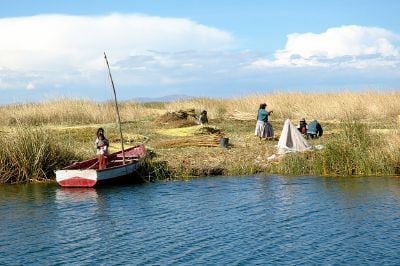
Peru is one of the four Latin American nations with a large population of unmixed indigenous peoples. Around 35 percent of all Peruvians are classified as indigenous peoples, most of whom are found in the southern Andes, though a large portion are also found in the southern and central coast due to displacement during the civil war (1985-2000) and the massive internal labor migration from remote Andean and Amazonian regions to coastal cities, especially Lima. While the Andes are the "heart" of indigenous Peru, Amazonia's rich biodiversity is matched by the wide variety of indigenous peoples residing in the region.
The two major indigenous groups are the various Quechua-speaking populations, followed closely by the Aymar√° (mostly found in the extreme southern Andes), as well as dozens of indigenous cultures dispersed throughout the country beyond the Andes and in the Amazon River basin.
A large proportion of Peru's indigenous peoples who live in the Andean highlands still speak Quechua or Aymara and have vibrant cultural traditions, some of which were part of the Inca empire, arguably the most advanced agricultural civilization in the world. In the tropical Andes and lowlands of the Amazon, which represents nearly 60 percent of Peruvian territory, one notes some of the planet's greatest cultural and biological diversity.
Peruvian Amazonia is rapidly becoming urbanized yet is home to numerous indigenous peoples, though they are a minority compared to the total population. These tribes include the Ashianikas, Urarina, Cocama, and Aguaruna, to name just a few.
On the north coast there are still indigenous peoples who are descendants of cultures such as the Chimu, Chan Chan, Mochica, Tallan, and Tumpis. All of these tribes were ethnically closely related to high jungle Amazonian and Caribbean peoples that migrated here before the Incas-Quechuas conquered the northern regions of Peru and Ecuador. Most of the area had a strong Spanish presence, since most of the Spanish settled in the central and north coast and the Andes, so there are few pure indigenous inhabitants on the north coast.
At the national level, mestizos constitute the largest segment of the population: 45 percent. The term denotes people of mixed ancestry, be it European with indigenous, African, or Asian. Around three-fourths of the mestizos come from a mixed ancestry of European (basically Spanish descent) and indigenous descent. The remaining quarter of the mestizo group are of African (black) ancestry, with around three percent of Asian (Chinese) ancestry.
Around 17 percent of the population is classified as "white" and are mostly the descendants of Spanish colonizers (called criollos), though there are also descendants of immigrant families like Italians on the central coast, Germans in the central jungle, Chinese in the central-northern coast, and Japanese on the central coast. The majority of the Creole communities live in Peru's largest cities and on the northern coast; in the south, only Arequipa shows important Spanish influence.
Between five and six percent of Peruvians are classified as purely black (Afro-Peruvian); most of them live in coastal cities south of Lima. Another large segment of Afro-Peruvians is found west and just below the Andean chain of northern Peru, where sugarcane, lemon, and mango production is still of importance.
In Amazonia, some Afro-Peruvian families trace their origins to workers brought from the British islands of the Caribbean to participate in the rubber boom (1880-1920). But the only Amazon region where there is a visible black presence is the Huanuco region and Cerro de Pasco's jungle valleys, since African slaves fled to these tropical valleys from the Andes, where they worked as miners.
Peru has the second largest population of people of Japanese descent in Latin America, after Brazil. Many of them traveled to Japan in the 1980s and early 1990s as the economic situation in Peru worsened. Some, however, returned after the election of Peruvian-Japanese Alberto Fujimori as president in 1990. Peru also has a large community of Chinese descent, mainly living in Lima, where Peruvian-Chinese restaurants (called chifas) are commonplace. Historic communities of Chinese people are found throughout the Peruvian upper Amazon, including cities such as Yurimaguas, Nauta, and Iquitos. In contrast to the Japanese community, the Chinese appear to have intermarried much more. "Unmixed" Asians make up roughly three percent of the population of Peru, the largest percentage of any Latin American nation-state.
Language
Spanish is the official language, as well as‚ÄĒin the areas where they are predominant‚ÄĒQuechua, Aymara, and other native languages. Spanish is understood by virtually all Peruvians and is used by government, media, and in education and formal commerce. There has been an increasing and organized effort to teach Quechua in public schools in areas where it is spoken. The major obstacle to more widespread use of Quechua is that multiple dialects exist. Quechua, Aymara and the minor indigenous languages, were oral languages, and essentially remain so. Therefore, there is a lack of print media such as books, newspapers, software, magazines, technical journals, etc., in these languages. However, non-governmental organizations, as well as state-sponsored groups, are involved in projects to edit and translate major works into the Quechua language, which appeared in a printed version in 1560 in the form of a dictionary by Domingo de Santo Tom√°s.
Religion
Peru has prided itself on being a Catholic country since the late 1500s. At present, more than 80 percent of the population are Roman Catholics; most of the rest belong to Protestant faiths, the most important being Evangelists, Adventists, and Mormons. Indigenous communities have also created a symbiotic form of religion that is a popular form of Catholicism. Mixing Catholic saints with pre-Hispanic traditions allows them to maintain ancient forms of worship under the guise of Catholic rituals. For example, the indigenous feast of the Inti Raymi (summer solstice) is celebrated in many communities as the feast days of Saints Peter and Paul.
Huacas (sacred mountain places) are still deemed sacred deity dwellings that demand the respect and veneration of the indigenous populations. The Spanish Catholic missionaries were very aware of these Andean practices, which is why many Catholic churches were built on top of huacas and other pre-Hispanic temples.
Peruvians' notion of an afterlife very much follows Catholic notions of heaven, purgatory, and hell. Even indigenous groups have been heavily influenced by the Christian notions of Armageddon and rebirth. In Indian communities there are long-standing traditions of millenarians and of the second coming of the Inca ruler to punish the white colonizers. This symbiotic Christian/Andean second-coming myth initially gained strength in the resistance movement of Tupac Amaru that challenged Spanish colonialism in the seventeenth century.
Culture
Like its rich national history, the popular culture of contemporary Peru is the result of a fusion of cultures, constituted primarily from the cultural legacy of the indigenous groups, and Spanish and African colonists. This cultural mixture has been further enriched by the contributions of other immigrant groups, particularly Asians and non-Iberian Europeans.
Peruvian artistic creation
Peruvian cultural patrimony has its origin in the magnificent Andean civilizations, which flourished before the Spaniards’ arrival. Peru's archaeological treasures are evidence of many significant achievements comparable to those of other great civilizations.
Some of the first artistic manifestations reflecting more advanced intellectual and technological evolution are artifacts found in the deposits of Chavín de Huántar and Cupisnique. These are examples of symbolic and religious art including gold and silver work, ceramics, architecture and stone sculpture. These sites date as far back as the fourteenth century B.C.E. and eleventh century B.C.E., respectively.
Between the eighth century B.C.E. and first century C.E., the Paracas Cavernas and Paracas Necrópolis cultures developed. The Paracas Cavernas culture produced beautiful polychrome ceramics with religious representations as well as monochrome ceramics. The Paracas Necrópolis culture is characterized by its delicate fabrics in complex styles.
In the period between the third century B.C.E. and seventh century C.E., the urban culture known as Mochica developed in Lambayeque. Nazca culture also developed in this period in the valley of río Grande, in Ica. In Mochica culture, the magnificent Huaca del Sol and Huaca de la Luna and the Huaca Rajada of Sipan are worth mentioning. They are notable for their cultivation in terraces and hydraulic engineering, as well as some of the most original ceramics, textiles, and pictorial and sculptural art in the Andean world.
The Wari civilization, which flourished between the eighth century and twelfth century C.E., was based in Ayacucho. This civilization may have been the first Andean culture to define a planned urban layout. Such a concept was later expanded to zones like Pachacamac, Cajamarquilla, Wari Willca, and others. Tiahuanaco culture developed by the borders of Lake Titicaca between the ninth and thirteenth centuries. This culture introduced monumental lithic architecture and sculpture as well as military urbanism. These advances in architecture were possible due to the discovery of bronze for making tools.
The Chim√ļ town improved on the principle of urban architecture. This civilization built the city of Chan Chan in the valley of the Moche river, in La Libertad, between the fourteenth and fifteenth centuries. The Chim√ļ were also skillful goldsmiths and made remarkable works of hydraulic engineering.
The Inca Civilization incorporated, and in many cases perfected, many of the cultural techniques of the civilizations that preceded it. There are many examples of original Inca architecture and engineering that have outlasted later Spanish colonial structures. In this regard, the rich Inca heritage can still be observed in cities like Cuzco, the fortress of Sacsahuaman, Ollantaytambo, Machu Picchu, and extensive stone roads that united Cuzco with the four cardinal points of the Inca Empire. The Spanish conquest displaced, not without violence, native artistic practices and concepts, although in many cases, it made for enriching hybrids of traditional Spanish and native art.
Architecture
Peruvian architecture is a conjunction of European styles exposed to the influence of indigenous imagery. Two of the most well-known examples of the Renaissance period are the Cathedral and the church of Santa Clara of Cuzco. After this period, the mestization reached its richer expression in the Baroque. Some examples of this Baroque period are the convent of San Francisco de Lima, the Church of the Compa√Ī√≠a and the facade of the University of Cuzco and, overall, the churches of San Agust√≠n and Santa Rosa of Arequipa, its more beautiful exponents.
The independence war left a creative emptiness that Neoclassicism of French inspiration could fill. The twentieth century is characterized by eclecticism. The best example is San Martin Plaza in Lima.
Art
The art of Peru was shaped by the melting between Spanish and Amerindian cultures. During pre-Columbian times, Peru was one of the major centers of artistic expression in the Americas, where pre-Inca cultures developed high-quality pottery, textiles, jewelry, and sculpture.
Drawing upon the earlier cultures, the Incas continued to maintain these crafts but made even more impressive achievements in architecture. The mountain town of Machu Picchu and the buildings at Cuzco are excellent examples of Inca architectural design.
During the colonial period, the Spanish baroque style fused with the rich Inca tradition to produce mestizo art. The Cuzco school of largely anonymous Indian artists followed the Spanish baroque tradition, with influence from the Italian, Flemish, and French schools.
The early twentieth century brought "indigenismo," expressed in a new awareness of Indian culture. Since World War II, Peruvian writers, artists, and intellectuals have participated in worldwide intellectual and artistic movements, drawing especially on U.S. and European trends.
During the 1960s, Fernando de Szyszlo became the main advocate for abstract painting and pushed Peruvian art toward modernism. Promising young artists continue to develop now that Peru's economy allows more promotion of the arts.
Music
Like its geography, its cuisine, and its various ethnicities, Peruvian music is very diverse. Much of Peru's music is derived from Andean, Andalusian Spanish, and African roots. Modern Peruvian music and Amazon-influenced music is also common in Peru.
The Pre-Hispanic Andean musicians mostly used wind instruments and diverse membranophone instruments such as the tinya (hand drum), the wankar, instrument of big dimensions, the pomatinyas (made of puma skin, and the runatinyas (made of human skin). The runatinya was also used in battles.
With the Spanish conquest, new instruments arrived like harps, guitars, vihuelas, bandurrias, lutes, etc. Due to these instruments, new crossbred Andean instruments appeared. Of these crossbred instruments, the Andean harp and the charango are still used. The sounding box of the charango is made of the armadillo's shell.
Cultural crossbreeding did not limit itself to the contact of indigenous and European cultures. The African slaves' contribution was demonstrated in rhythms and percussion instruments. This influence is visible in musical forms like festejo, zamacueca, etc.
Coastal music is rooted in the haciendas and the callejones of cities such as Lima, Trujillo, Chiclayo, Piura, Tumbes, and Ica. It involves a creole version of the Spanish guitar and the famous Peruvian instrument, the Cajon drum.
Dances
Among dances of native origin, some are related to agricultural work, hunting, and war, while others show Christian influence. Two of the most representative Andean dances are the kashua and the wayno or huayno. The kashua has a communal character and it is usually danced in groups in the country or open spaces. The huayno is a "salon ball" danced by couples indoors. The yaravi and the triste have an Andean origin. They are usually songs with very emotional lyrics.
Dances of ritual character are the achocallo, the pinkillada, the llamerada (a dance that imitates the llama's walk), the kullawada (the spinners' dance), etc. Among hunting dances, the llipi-puli and choq'elas are dances from the altiplano related to hunting vicu√Īas.
Some dances of war like the chiriguano have an Aymara origin; the chatripuli satirizes the Spanish Realist soldiers, and the kenakenas is about the Chilean soldiers who occupied Peru during the War of the Pacific (1879). There are also Carnival dances. At harvest, many rural communities celebrate youths' initiation with ancestral rites and crossbred dances. New couples might be established.
The most attractive and internationally known Love Dance in Peru is the Marinera Norte√Īa. This dance represents a man's courting a young woman. There are local variants of this dance in Lima and the other regions of the country.
Popular celebrations
Popular celebrations are the product of every town's traditions and legends. These celebrations gather music, dances, meals, and typical drinks. In addition to religious celebrations like Christmas, Corpus Christi, or Holy Week, others express the syncretism of indigenous beliefs with Christian ones.
Cuisine
Peruvian cuisine, for years unnoticed abroad, has recently exploded onto the world gastronomic scene. Peruvian cuisine is a blend of Amerindian and Spanish roots but has also been influenced by other groups, including African, Italian, Chinese, and Japanese, all of whom have added their own ingredients and traditions to the mix.
Peru's many climate zones also make it possible to grow a wide range of crops. There are the dozens of native potato, maize, and chile pepper varieties from the Andes, to the plentiful fish and seafood from the Pacific coast, mangoes and limes from the coastal valleys, bananas and manioc from the jungle.
Among the most typical dishes are cebiche, also spelled "ceviche" (fish and shellfish marinated in lime juice; chupe de camarones (a soup made of shrimps; the anticuchos (roasted beef heart); the olluco con charqui (a casserole dish made of ulluco and charqui); Andean pachamanca (meats, tubers, and broad beans cooked in a stone oven); lomo saltado (meat fried lightly with tomato and onion, served with French fries and rice), that has a Chinese influence; and picante de cuy (a casserole dish made of fried guinea pig with some spices). The most popular ceviche is a type of seafood cocktail where the fish has been marinated in lime juice with onions and hot peppers but not cooked. The lime's acid precipitates the protein and hence turns the fish white, "cooking" it. There are several types of ceviche that include fish only, mixed seafood, mussels, etc.
Sports
The most popular Peruvian sport is football (soccer) (World Cup appearances: 1930, 1970 (quarterfinalists), 1978 (quarterfinalists), 1982 and two Copa America trophies). Most of the population of Peru follow the World Cup tournament on television.
Paleta Fronton, the only sport truly born in Peru, has its roots in "Pelota Vasca" and "Hand Ball." Played with a wooden racquet and a hollow rubber ball filled with air, and in a court consisting of a concrete wall and floor, Paleta Fronton is growing in popularity and now is played in Costa Rica and Mexico as well.
Notes
ReferencesISBN links support NWE through referral fees
- Bingham, Hiram. Lost City of the Incas: The Story of Machu Picchu and its Builders. London: Weidenfeld & Nicolson, 2002. ISBN 0297607596
- Buckman, Robert T. Latin America. World Today Series. Harpers Ferry, WV: Stryker-Post Publications, 2006. ISBN 1887985751
- Falconer, Kieran, and Lynette Quek. Peru. Cultures of the World series. New York: Marshall Cavendish, 2006. ISBN 0761420681
- Hunefeldt, Christine. A Brief History of Peru. New York: Checkmark Books, 2004. ISBN 081605794X
External links
All links retrieved August 26, 2023.
- CIA, Peru The World Factbook.
- Volunteer in Peru Cadip.
- Peru - A Country Study
- Peru US Department of State.
- Peru Travel
- Peru Travel Guide National Geographic.
- Peru UNESCO World Heritage Convention.
Credits
New World Encyclopedia writers and editors rewrote and completed the Wikipedia article in accordance with New World Encyclopedia standards. This article abides by terms of the Creative Commons CC-by-sa 3.0 License (CC-by-sa), which may be used and disseminated with proper attribution. Credit is due under the terms of this license that can reference both the New World Encyclopedia contributors and the selfless volunteer contributors of the Wikimedia Foundation. To cite this article click here for a list of acceptable citing formats.The history of earlier contributions by wikipedians is accessible to researchers here:
The history of this article since it was imported to New World Encyclopedia:
Note: Some restrictions may apply to use of individual images which are separately licensed.


